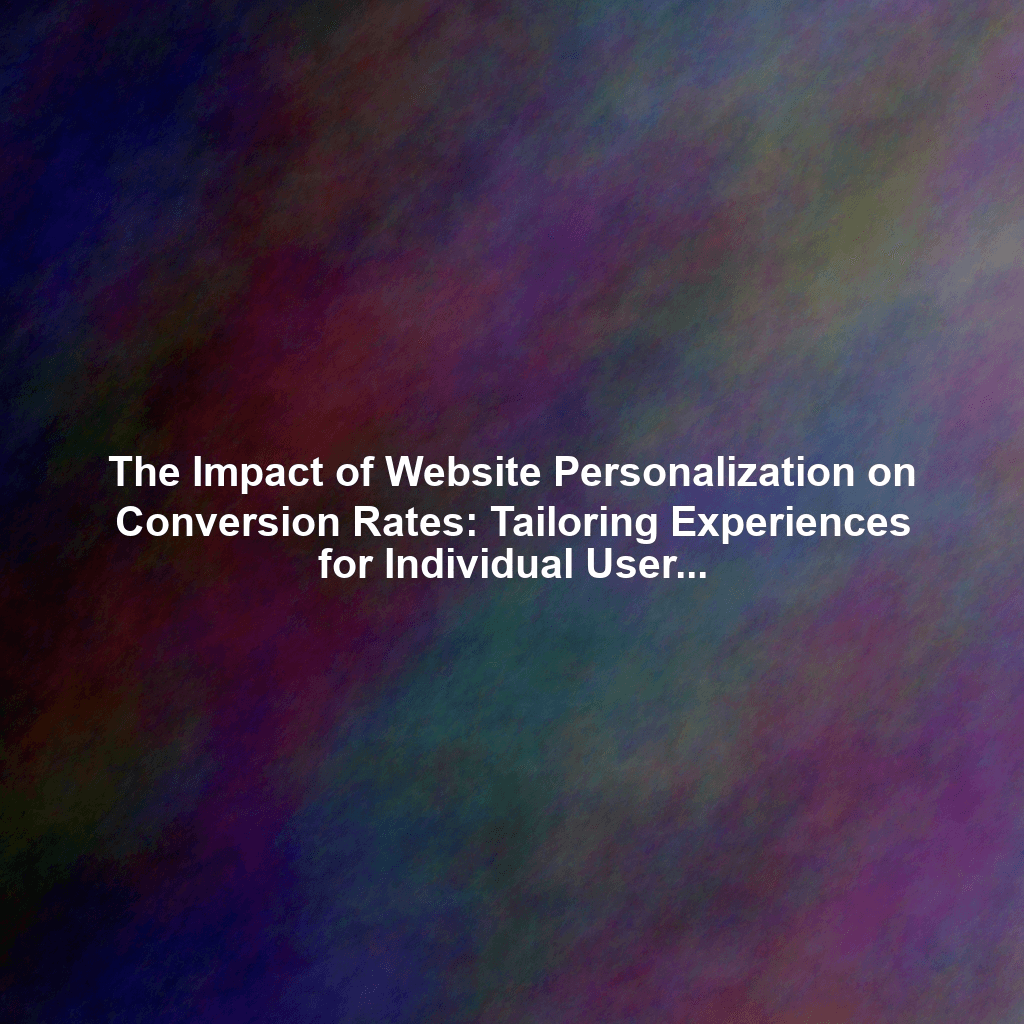In today’s competitive digital landscape, generic website experiences simply don’t cut it. Users are bombarded with information and demand relevance. That’s where website personalization comes in – a powerful strategy that tailors the online experience to individual users, leading to increased engagement, improved customer satisfaction, and, most importantly, higher conversion rates. But how exactly does personalization work, and how can you implement it effectively? This article explores the benefits, strategies, and ethical considerations of website personalization for optimal conversion rate optimization (CRO).
Why Website Personalization Matters for Conversion Rates
Imagine walking into a store where the staff knows your name, remembers your previous purchases, and offers recommendations based on your preferences. That’s the level of service personalization aims to provide online. By delivering relevant content, offers, and experiences, you can:
- Increase Engagement: Personalized experiences capture attention and keep users on your site longer.
- Improve User Experience: Tailored content reduces friction and makes it easier for users to find what they need.
- Boost Conversion Rates: By showing users what they want to see, you increase the likelihood of them taking desired actions, like making a purchase or signing up for a newsletter.
- Strengthen Customer Loyalty: Personalized interactions make users feel valued and build long-term relationships.
Effective Strategies for Implementing Website Personalization
Personalization isn’t just about adding a user’s name to an email. It requires a strategic approach involving data collection, segmentation, and dynamic content creation.
Data Collection: The Foundation of Personalization
The first step is gathering data about your users. This can be achieved through various methods:
- Website Analytics: Tools like Google Analytics provide valuable insights into user behavior, demographics, and interests.
- CRM Data: Customer Relationship Management (CRM) systems contain a wealth of information about your customers, including purchase history, communication preferences, and demographics.
- Surveys and Quizzes: Directly ask users about their needs and preferences through surveys and quizzes.
- Social Media Data: Analyze social media activity to understand user interests and behaviors.
- Behavioral Tracking: Monitor user actions on your website, such as pages visited, products viewed, and links clicked.
Segmentation: Grouping Users for Targeted Experiences
Once you have data, you need to segment your audience into groups based on shared characteristics. Common segmentation strategies include:
- Demographic Segmentation: Grouping users based on age, gender, location, and other demographic factors.
- Behavioral Segmentation: Grouping users based on their actions on your website, such as browsing history and purchase behavior.
- Psychographic Segmentation: Grouping users based on their values, interests, and lifestyle.
- Technographic Segmentation: Grouping users based on the technology they use, such as device type and browser.
- Lifecycle Stage Segmentation: Grouping users based on where they are in the customer journey (e.g., new visitor, returning customer, loyal advocate).
Dynamic Content Creation: Delivering Personalized Messages
With user segments defined, you can create dynamic content that resonates with each group. This can include:
- Personalized Product Recommendations: Suggesting products based on past purchases or browsing history.
- Targeted Offers and Promotions: Displaying discounts or promotions that are relevant to specific segments.
- Customized Website Content: Adapting website content to match user interests and preferences.
- Personalized Email Marketing: Sending targeted email campaigns based on user behavior and demographics.
- Location-Based Personalization: Displaying content and offers that are relevant to a user’s location.
Examples of Personalization in Action
- E-commerce: Displaying “Customers who bought this also bought…” suggestions based on the user’s current selection.
- News websites: Presenting articles based on the user’s previously read topics.
- Travel websites: Showing flight and hotel recommendations based on the user’s travel history and preferences.
- Subscription services: Offering personalized content recommendations based on viewing habits.
Ethical Considerations for Website Personalization
While personalization offers significant benefits, it’s crucial to implement it ethically and transparently. Key considerations include:
- Data Privacy: Obtain user consent before collecting and using their data. Clearly explain how you will use their information and provide options for opting out.
- Transparency: Be upfront about your personalization efforts. Let users know that they are seeing tailored content and explain why.
- Data Security: Protect user data from unauthorized access and breaches.
- Avoid Discrimination: Ensure that your personalization efforts do not discriminate against any group of users.
- Provide Control: Give users control over their personalization settings. Allow them to customize their experience and opt out of specific personalization features.
Measuring the Success of Your Personalization Efforts
To determine whether your personalization strategy is working, track key metrics such as:
- Conversion Rates: Track the percentage of users who complete desired actions.
- Engagement Metrics: Monitor time on site, bounce rate, and pages per session.
- Customer Satisfaction: Measure customer satisfaction through surveys and feedback forms.
- Revenue: Track the impact of personalization on revenue and average order value.
A/B testing is an essential tool for measuring the impact of your personalization efforts. Compare the performance of personalized experiences against generic experiences to determine which performs best.
Conclusion
Website personalization is a powerful tool for boosting conversion rates and creating more engaging and satisfying user experiences. By collecting data, segmenting your audience, and creating dynamic content, you can tailor the online experience to individual users and drive conversions. However, it’s crucial to implement personalization ethically and transparently, respecting user privacy and providing control over their data. By following these guidelines, you can unlock the full potential of website personalization and achieve significant improvements in your conversion rate optimization efforts. The key is to always put the user first and strive to create experiences that are both relevant and valuable.
 Skip to content
Skip to content

